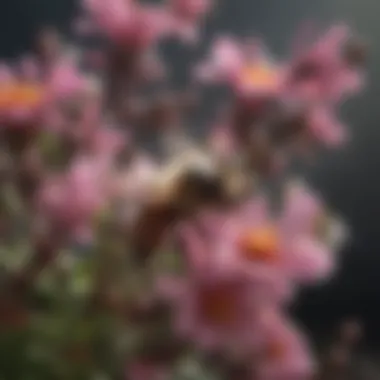Impact of Global Bee Population Decline


Intro
The alarming decline in bee populations has stirred up conversations across scientific communities and beyond. We're not just talking about a few buzzing creatures disappearing from our gardens; this is about a significant shift with deep repercussions. Bees play a crucial role in pollinating plants, which is essential for food production and maintaining biodiversity. Picture this: our diets packed with fewer fruits, nuts, and vegetables, not to mention a serious impact on the overall ecosystem.
Understanding the multifaceted effects of the dwindling bee numbers is paramount. The intricate relationships bees share with flowering plants directly affect agricultural output and economic stability. We must delve into these interconnections, examining how the absence of bees leads to a cascading effect on both natural and human systems.
In this article, we’ll dissect various repercussions tied to this urgent issue, from biodiversity loss which puts countless species at risk, straight down to economic consequences that could hit farmers hard. Mind you, it ain't just about looking at the negative side. We will also explore potential solutions and the innovative strides people are taking to turn the tide. So grab your metaphorical magnifying glass as we embark on this journey of analysis and understanding!
Preface to Bee Population Decline
The declining populations of bees have started to sound alarm bells around the globe. It's not just about losing a few buzzing friends in the garden; it’s a matter that touches almost every corner of our ecosystems and agricultural landscapes. As students, researchers, educators, and various professionals delve into this critical issue, understanding the significance of bee population decline is crucial. One might ponder, why should this concern us all? Well, the facts are sobering.
Bees are like the unsung heroes of our environment. They facilitate the pollination of about 75% of the world’s flowering plants, many of which contribute to our food supply. If this vital workforce dwindles, we face drastic ramifications for biodiversity and food availability. The intricate webs that support both wildlife and human existence are heavily influenced by the health of bee populations. Through a careful analysis of their decline, we can uncover essential relationships across species, habitats, and human economies.
Understanding Bee Species Diversity
In order to grasp the consequences of bee population decline, it's important to first appreciate the richness of bee diversity. There are approximately 20,000 known species of bees, ranging from the well-known honeybee to solitary types like mason bees. Each species plays a unique role in its ecosystem, with specific preferences for flowers and nesting habits. This diversity isn’t just a collection of buzzing creatures; it’s a network of relationships with plants, animals, and humans, all intricately woven together.
A vivid example of this diversity can be seen in urban settings. For instance, a neighborhood garden might attract several bee species that pollinate different varieties of plants throughout the growing season. This diverse mix ensures that flowers receive pollen from the right sources, increasing the chances of producing healthy seeds and fruits. If one species faces a decline, others with similar habits might not fill the void as effectively, leading to disrupted pollination patterns and diminished plant populations.
Historical Trends in Bee Populations
Bee populations have fluctuated for decades, but recent trends are concerning. Historical data suggests that, as urban sprawl increased and agricultural practices intensified post-World War II, bee populations started to decline significantly. Pesticide usage skyrocketed during that era, and a shift towards monoculture farming reduced the variety of plants available to bees, leading to a loss of habitat.
A case in point is the decline of native bee species in North America, which saw a reduction in their numbers by nearly 50% over the past century. Data shows that in certain regions, the variety of bee species is also narrowing, meaning fewer partners in the pollination game.
"The gradual diminishment of bee populations is akin to removing pieces of a fundamental puzzle from our ecosystem. Each lost species represents lost connections that are hard to replace."
Understanding these historical trends provides context for today's challenges and highlights the urgency of addressing the ongoing decline. In summary, the interplay between bee diversity and historical population changes assists in forming a clear picture of the pressing issues that must be tackled to protect these vital insects.
In uncovering this narrative of bee population decline, it emerges not only as a pressing environmental concern but also as an urgent call to action for all of us.
Importance of Bees in Ecosystems
Bees are often called the unsung heroes of our environment, playing a pivotal role in the survival and growth of ecosystems. Their contribution goes beyond just honey production; it touches the very fabric of biodiversity and agricultural sustainability. Without bees, many plants may struggle to reproduce, leading to a cascade of adverse effects throughout the food web. This section delves into the intricate importance of bees, focusing on their roles in pollination and the maintenance of ecological balance.
Pollination Dynamics
Pollination is fundamental for the reproduction of about 75% of the world's flowering plants, and bees are prime actors in this essential process. When bees visit flowers, they inadvertently transfer pollen from male anthers to female stigmas, allowing fertilization to occur. This tiny act has significant implications: it leads to the production of fruits and seeds, thereby shaping plant populations and, in turn, the animals that depend on those plants for food.
- Many crops we rely on—like apples, almonds, and cucumbers—rely heavily on bee pollination. Without their tireless work, yields would plummet, and food supplies would be severely threatened.
- Beyond agriculture, wild plant species also rely on bees. They ensure genetic diversity within plant populations, which is crucial for resilience against diseases and climate changes.
The dynamics of pollination are intricate; different bee species are attracted to varying types of flowers, which means a diverse bee population can support a wide array of plant species. The relationship is symbiotic: bees get nectar and pollen while plants secure reproduction.
"A world without bees would see a staggering reduction in food availability and plant diversity, forcing ecosystems into precarious balances."
Biodiversity and Ecological Balance
The role of bees extends far beyond individual plant species and crops; it is integrally connected to the notion of biodiversity and ecological stability. A robust bee population supports not just plants, but a complex web of life that includes other insects, animals, and even birds.
The benefits of biodiversity, enhanced by bees, can be summarized as follows:
- Habitat Stability: Healthy bee populations contribute to diverse floral communities, which provide habitats and food for other species, ensuring a balanced ecosystem.
- Nutrient Cycling: Bees foster conditions that lead to healthier soil through the growth of diverse root systems and plant litter, promoting nutrient recycling essential for the ecosystem's health.
- Resilience to Change: Ecosystems rich in biodiversity can better withstand disturbances, be it a rise in temperature or a sudden disease outbreak. The interplay between various bee species and plants helps create a buffer against such phenomena.
In summary, bees are not merely pollinators; they are agents of ecological balance, contributing to the intricate network of life that sustains our planet. Their decline triggers a domino effect, threatening not only plant species but entire ecosystems, hence underscoring the urgency of addressing this issue.
Consequences for Plant Life
Understanding the consequences of bee population decline is crucial as it directly impacts various aspects of plant life and, consequently, the broader ecosystem. Bees are not just mere participants; they are essential actors in the life of many flowering plants. Their decline signals a broader ecological upheaval that threatens not only plant species but also the myriad biotic interactions that sustain them.
Impact on Pollinator-Dependent Species
Pollinator-dependent species rely heavily on bees for their reproduction. Without these diligent workers, many plants face a dire future. For instance, consider the case of blueberries, which need bees for proper pollination. If the bee population continues to dwindle, we can expect a steep decline in blueberry yields, impacting not just farmers but also consumers who take delight in these healthy snacks.
The relationship between bees and specific plants can be likened to a well-oiled machine; without one part properly functioning, the entire system starts to falter. Some species are so specialized that they are almost entirely dependent on certain types of bees for pollination. For example:
- Orchids: Many have evolved intricate relationships with specific bee species that are crucial for their reproductive success. If those bee species decline, the orchids may not reproduce at all.
- Almonds: Farmers rent thousands of beehives during blooming season because almond trees absolutely depend on bees for pollination. A reduction in bee populations could spell disaster for almond crops.
Without bees, the diverse array of pollinator-dependent species faces extinction, resulting in serious ramifications for food webs and biodiversity.
Effects on Plant Reproduction


The effects of bee population decline extend into the realm of plant reproduction. A plant's ability to propagate its species largely hinges on successful pollination. With fewer bees buzzing around, odds of successful pollination diminish. This gives rise to a litany of challenges for the plant life cycle.
Many plants engage in intricate strategies to attract pollinators, such as producing sweet nectar or vibrant blooms. When bee populations are healthy, these mechanisms work seamlessly, ensuring that pollen is transferred efficiently from flower to flower. However, when this balance is thrown off by bee loss, we see novel problems arise:
- Lower Seed Production: Many plants will produce fewer seeds if pollination is inadequate, leading to a decline in future generations.
- Altered Genetic Diversity: Pollinators help facilitate cross-pollination, which allows for greater genetic diversity. If bees are scarce, plants may resort to self-pollination, leading to inbreeding and a reduction of genetic diversity, which is pivotal for resilience in changing environments.
- Ecosystem Imbalance: Fewer plants mean fewer habitats available for many other species, further destabilizing the ecosystem.
The ripple effects of diminished plant reproduction feed back into the environment and agricultural systems, underscoring the interconnectedness of life and the potential repercussions of bee decline.
Implications for Agriculture
Understanding the implications of bee population decline on agriculture is not just an academic exercise; it’s a core issue that affects food production and economic stability. Bees play an undeniable role in pollination, which is crucial for many crops. Without them, the agricultural landscape would change dramatically, leading to significant challenges. The sluggish buzz of bees not only supports natural ecosystems but also sustains human livelihoods and the global food supply.
Economic Contributions of Bees
When one thinks of bees, they often think of honey. However, bees contribute far more than just sweetness to our lives. The economic value of bee pollination is staggering. In the United States alone, honey bees are responsible for pollinating nearly $15 billion worth of crops each year, including fruits, vegetables, and nuts. Without these industrious insects, our grocery store aisles would look quite bare.
- Prominent crops that rely on bees include:
- Apples
- Blueberries
- Almonds
- Watermelons
These staple foods owe their successful growth and viability to bee pollination. The economic knock-on effects extend to farmers, retailers, and ultimately consumers. Higher production costs from reduced yields could lead to increased prices at the checkout. Moreover, local economies that rely on agricultural profits could suffer greatly from bee decline. It’s hard to overstate the chain reaction that can occur when bee populations dwindle.
Impact on Crop Yields
As bee numbers dwindle, one of the most immediate effects seen on farms is a decrease in crop yields. Different crops have varying dependencies on bee pollination. For instance, crops like squash and cherries show a marked reduction in fruit set when bees are scarce. This spike in demand without the necessary supply mirrors the frustrations consumers face today in their shopping habits.
Farmers may need to resort to alternative methods, such as hand pollination or utilizing other insect species, which are both time-consuming and costly. Yet, even these methods may not match the efficiency of natural pollination.
"The decline of bees is not just an environmental problem; it’s an agricultural crisis waiting to unfold."
The consequences of reduced crop yields ripple through the food supply chain, affecting everything from farm profitability to food prices. Additionally, some annual crops may see yields diminish so significantly that they become economically unviable to grow, urging farmers to pivot to less preferred alternatives, thus drawing us into a cycle of agricultural instability.
Wider Environmental Effects
The interconnected web of nature illustrates how everything is linked. Within this framework, bees stand as tiny powerhouses that facilitate a broader ecological equilibrium. The decline in bee populations doesn’t just affect their immediate environment; it reverberates throughout ecosystems. When we consider the role bees play, we must recognize the ripple effect their decline creates.
Impact on Food Webs
To understand the impact of reduced bee numbers, let’s take a closer look at food webs. At its core, a food web represents the intricate relationships between species in an ecosystem. Bees, primarily through their pollination activities, are pivotal in sustaining flowering plants. Without them, many of these plants struggle to reproduce, leading to a significant drop in populations.
If flowering plants start to diminish, they directly affect herbivores that rely on these plants for nourishment. Think of it this way: if you remove a piece from a jigsaw puzzle, the picture becomes incomplete. In turn, herbivores like rabbits or caterpillars face food shortages. This scarcity naturally climbs the food chain, leaving carnivores like foxes and birds of prey with fewer available food sources. The consequences can result in population declines for species that depend on these herbivores, showcasing a domino effect catalyzed by bee population decline.
"Every little thing counts in the grand scheme of things, and bees are far from exempt from that truth."
Effects on Soil Health
Soil health is another crucial aspect that suffers from dwindling bee populations. Healthy ecosystems thrive on nutrient cycling, and bees are indirectly influential in this process. When bees pollinate plants, they contribute to a diverse plant community. A rich variety of plants not only supports various animal species but also enhances soil quality through root systems and organic matter.
Furthermore, when flowering plants reproduce and thrive, they create litter that decomposes and enriches the soil. This organic material builds up soil structure, enhances moisture retention, and boosts nutrient availability. When bee populations decline, the decline in plant diversity means less organic matter and fewer nutrients for the soil.
Healthy soil acts as a natural sponge, retaining water and minimizing erosion. A decline in bee populations, therefore, sets off a chain reaction – diminishing flowering plants leads to poorer soil quality, which in turn affects water retention and ecosystem resilience in the face of disturbances like drought.
In short, the decline of bee populations mirrors wider environmental vulnerabilities. Each piece of the ecosystem is interconnected, meaning the preservation efforts of bees is vital, not merely for bees themselves but for the health of whole environments, including human agricultural systems.
Causes of Bee Population Decline
Understanding the causes behind the decline in bee populations is pivotal for grasping the larger picture of environmental health and agricultural productivity. Bees are not just insects; they are vital players in the ecosystems they inhabit, contributing significantly to pollination and thus the health of plant communities and food crops. As these populations dwindle, the repercussions echo through various aspects of life. The exploration of key causes helps us delineate strategies to combat this alarming trend, ensuring the sustainability of our ecosystems and food systems.
Pesticide Use and Chemicals
The role of pesticides and other chemicals in the decline of bees cannot be overstated. These substances, designed to protect crops from pests, often end up harming the very pollinators that are essential for crop growth. Chemicals like neonicotinoids, which affect the nervous systems of insects, have been particularly notorious.
- Acute Toxicity: High doses can kill bees on contact or shortly after exposure.
- Chronic Effects: Sublethal effects include impaired foraging behavior and reduced reproductive success.
- Compounding Factors: Several studies suggest that pesticides can make bees more susceptible to diseases and parasites.
Additionally, many farmers might not realize the long-term impact of their pesticide choices, leading to a cycle that can devastate bee populations. The ramifications don't stop at agriculture; as bees decline, the quality and availability of a wide variety of plants diminish, affecting entire food webs.
"The impact of chemicals used in agriculture on bee health must be seen as a pressing issue, as it intertwines with broader ecological relationships."
Habitat Loss
Habitat loss is another significant driver behind the declining bee populations. Urbanization and agricultural expansion have led to the destruction of wildflower meadows and natural landscapes that bees rely on for food and nesting.


- Urban Sprawl: Cities expand, consuming spaces where bees once thrived.
- Monoculture Farming: Large-scale farming often shifts away from diverse crops to single-crop systems, reducing the variety of plants available for bees.
- Fragmentation: Even where habitats remain, fragmentation can isolate bee populations, making it hard for them to find sufficient food sources and mates.
The loss of these critical habitats not only impacts bees but also a myriad of other species that share these ecosystems. Restoring habitats and promoting biodiversity is essential for the survival of bee populations and the overall health of our environments.
Climate Change
Climate change adds another layer of complexity to the challenges bees face. As temperatures rise and weather patterns become more erratic, the delicate balance of ecosystems is thrown off-kilter.
- Floral Mismatch: Pollinators rely on specific blooming times of plants. Climate change can disrupt these synchronies, leaving bees without sufficient food when they emerge in spring.
- Extreme Weather: More frequent storms can destroy habitats and nesting sites, while droughts can limit the availability of flowering plants.
- Range Shifts: Some bee species may be forced to migrate to cooler areas, but not all species can adapt or migrate effectively.
It's crucial to recognize that climate change doesn’t exist in isolation; it interacts with other factors like habitat loss and pesticide use, creating a perfect storm that threatens bee populations on a global scale.
Societal Implications
The importance of understanding the societal implications of bee population decline cannot be overstated. As bees play critical roles in pollination and maintaining biodiversity, their decline is intertwined with various social, economic, and ecological factors that affect communities worldwide. This section aims to delve into how the dwindling bee populations disturb not only ecological balances but also the fabrics of human societies at multiple levels.
Cultural Significance of Bees
Bees hold a special place in many cultures, symbolizing hard work, community, and the interconnectedness of life. For instance, in ancient Egypt, bees were revered as agents of the sun god Ra, while in various indigenous cultures, they symbolize productivity and harmony with nature. The current decline of bees threatens these cultural narratives, altering the way communities perceive their relationship with the natural world.
Art, folklore, and culinary traditions often reflect the role of bees. Honey, a product of bees, has been valued not only for its sweetness but also for its medicinal properties. In places like Greece, honey harvesting is a time-honored practice passed down through generations. Losing bees not only diminishes honey production but potentially erases these cultural practices.
Moreover, bees influence our cuisines. Many traditional dishes depend on ingredients pollinated by bees, such as almonds, blueberries, and avocados. As these crops face decline, the culinary heritage of numerous cultures may thin out, leading to a homogenization of diets and a loss of unique gastronomic traditions.
Public Awareness and Education
Raising public awareness surrounding bee declines is crucial for driving sustainable practices and conservation efforts. People often remain oblivious to the extent to which these tiny creatures shape our agricultural ecosystems and everyday life.
Educational programs targeting schools can help instill a respect for our buzzing companions. Initiatives like school garden projects, where students learn about beekeeping, not only foster a sense of community but also emphasize the importance of bees. Through programs like these, students understand hands-on how vital bees are to plant life and, by extension, to human survival.
In an age dominated by social media, campaigns utilizing platforms like Facebook and Reddit can spark conversations around the topic, drawing attention to proactive measures individuals can take. Simple actions, such as planting bee-friendly flowers or supporting local farmers using sustainable practices, can make a significant impact.
"Bees are not just important in their own right; they serve as a bridge between society and the intricate web of life that we all depend on."
This connectivity highlights the need for comprehensive educational efforts that couple ecological knowledge with everyday actions. The more individuals understand the pressing issue of bee population decline, the more potent their voices will be in influencing policies and advocating for the preservation of these essential pollinators.
Possible Mitigation Strategies
The decline of global bee populations signals alarm bells not just for natural ecosystems but also for human survival. As we've seen, bees are essential for pollination, a process that ensures the health of plant life. To counteract their diminishing numbers, several possible mitigation strategies are on the table. Understanding these approaches is crucial as they could potentially alter the trajectory of both agricultural productivity and ecological balance.
Conservation Efforts
One of the front lines in the fight to preserve bee populations lies in conservation efforts. Initiatives aimed at protecting natural habitats can create safe havens for bees, allowing them to thrive. This includes the establishment of pollinator-friendly gardens, where plants native to the area provide nectar and pollen sources. Educating communities on the importance of native plants can foster a more bee-friendly environment.
Additionally, conservation is not limited to just land management. Organizations like the Xerces Society spearhead campaigns to implement best practices in maintaining bee habitats. These efforts can result in significant recovery of bee populations over time, rekindling the vital relationships bees have with flora.
"Effective conservation can create corridors that connect habitats, allowing for the movement and breeding of bee populations."
Sustainable Agricultural Practices
Agricultural practices play a major role in the health of bee populations. Transitioning to sustainable agriculture isn’t just a trendy phrase; it’s an essential strategy. By adopting practices such as crop rotation and polyculture, farmers can create diverse ecosystems that are beneficial for bees.
For example, minimizing the use of chemical pesticides or opting for organic pest control methods makes a substantial difference. By selecting crops that bloom at different times of the year, farmers can ensure that food is available for bees throughout their active seasons. Incorporating cover crops and wildflower strips can also provide necessary habitats and forage.
Among the advantages of sustainable practices is the possibility of improved yields—bees' pollination services can lead to increased quantity and quality of crops. This symbiotic relationship showcases that what benefits bees can also benefit farmers economically.
Legislation and Policy Changes
Policy reform holds the key to creating an environment conducive to bee recovery. Governments and institutions should take actionable steps to introduce regulations that protect bees. This could involve stricter controls on pesticide usage, especially harmful neonicotinoids, which research has shown to be particularly detrimental to bee populations.
Establishing protected areas specifically for ecological restoration would allow for the nurturing of bee habitats without interference. In addition, incentivizing farmers to adopt bee-friendly practices through subsidies can encourage a collective movement towards sustainability.
Stakeholders must come together—scientists, policymakers, and city planners—to ensure a multifaceted approach in legislation. Increased funding for research into bee health and habitat restoration is also vital. As these initiatives gain traction, they send a clear message: protecting our pollinators is not just an option but a necessity for future generations.
Case Studies of Bee Decline
Understanding the nuances of bee population decline is crucial for addressing and mitigating its effects on ecosystems and agriculture. Case studies serve as informative snapshots that provide insights into how specific regions and bee species react to changing environmental pressures. By observing these variations, researchers can identify patterns that may guide future conservation efforts. These studies not only highlight the complexity of bee populations but also underscore the interconnectedness of various ecological components.
Regional Variations in Bee Populations
Diving deeper into regional studies reveals that bee population status significantly varies based on local factors. For instance, consider the Midwestern United States where monoculture farming practices have drastically reduced native bee habitats. In these areas, certain species have seen alarming declines, as their natural nutrition sources are outcompeted or eradicated by large-scale agricultural operations. Conversely, in regions like the Pacific Northwest, some bee populations have fared better due to more diverse flora and smaller-scale farming.


- Key Factors Influencing Regional Variations:
- Habitat Type: Urban areas with community gardens may support diverse bee populations.
- Agricultural Practices: Areas that employ integrated pest management show improved bee health compared to those relying heavily on pesticides.
- Climate: Temperature and precipitation changes can affect blooming seasons and consequently, bee foraging.
By studying these regional differences, stakeholders can tailor conservation approaches based on local circumstances, ultimately aiding in broader bee recovery efforts.
Species-Specific Studies
Focusing on specific species brings to light the unique challenges faced by different bees. For example, the Rusty Patched Bumblebee in North America is now critically endangered, primarily due to habitat loss and pesticide exposure. In contrast, certain urban-adapted species, like the European Honeybee, show resilience by exploiting new food sources in city gardens.
In these species-specific examinations, researchers often uncover valuable lessons:
- Tolerance Levels to Environmental Stressors: Some bees display higher resilience to pesticide exposure or climate fluctuations, which can influence conservation priorities.
- Behavioral Adaptations: Urban bees have adapted in surprising ways; they often nest in non-conventional areas, like brick walls and rooftops, showcasing their adaptability.
Without realizing the intricacies involved in each species' plight, we may overlook critical insights that inform effective conservation strategies.
Moreover, understanding these individual characteristics can lead to targeted recovery plans for at-risk species. For example, specific floral resources can be promoted in areas where endangered species are found to help support their populations.
Research into case studies is not just a scholarly pursuit; it’s a necessary step for practical applications. The insights gained from examining regional differences and species behaviors will be vital in reversing the troubling trend of bee population decline. Ultimately, these narratives provide a roadmap for strategic action—a call to arms for conservationists, policymakers, and communities united in this cause.
Global Initiatives Addressing Decline
The decline of bee populations is not just a localized issue; it’s a global crisis that calls for collective action. The initiatives taken worldwide to combat this decline are not merely about saving bees but aim to safeguard ecosystems, food security, and economic stability. Understanding these global initiatives reveals the interconnectedness of our planet's wellbeing and the vital role bees play in sustaining life.
One of the most significant aspects of global initiatives is the recognition that the decline of bee populations affects more than just flora and fauna—it touches on human health and nutrition. The ripple effects of declining bee populations lead to poorer crop yields, threatening food supplies and even triggering economic fluctuations. Thus, international cooperation becomes paramount.
International Programs and Policies
Around the world, various programs and policies are being implemented to address bee population declines. These are forged by both governmental and non-governmental organizations. For instance, the European Union’s Pollinators Initiative seeks to create a framework for reducing pesticide use while promoting sustainable farming practices. This initiative not only seeks to restore bee populations but also fosters biodiversity and healthy agricultural remedies.
Similarly, The United Nations Environment Programme (UNEP) highlights the importance of integrating bee health into broader conservation strategies. They stress that protecting bees can lead to fostering resilient ecosystems that also benefit agriculture, highlighting a win-win scenario.
The landscape is continuously evolving, and new policies must adapt to emerging challenges associated with bee health. Policymakers consider vital elements:
- A need for regulatory frameworks that minimize chemical usage
- Encouraging organic farming methods
- Promoting habitat restoration for pollinators
"The key to averting a crisis lies not only in awareness but also in action—concrete steps that resonate across borders and communities."
Collaboration Between Countries
Global issues often require a unified front. Countries worldwide are beginning to realize that saving bees isn’t just a national interest but a global imperative. Collaborative efforts between nations, from the United States to Japan, cultivate shared resources, research findings, and strategies to tackle bee population decline.
Notable collaborations include the Bees for Development Alliance that promotes cross-border partnerships to develop sustainable beekeeping initiatives. Their model emphasizes the transfer of knowledge and practices that can thrive in different environments, which is crucial as bees adapt to changing conditions.
Furthermore, international conferences and summits, such as the Global Pollinator Conference, facilitate dialogue among policymakers, scientists, and educators. These platforms not only focus on challenges but also spotlight success stories and innovative methods being tested around the globe.
Key considerations in fostering collaboration include:
- Sharing best practices in bee conservation efforts
- Conducting joint research projects
- Establishing funding mechanisms that bridge financial gaps in bee advocacy
Future Research Directions
The study of bee population decline opens a treasure trove of potential research avenues, each promising to shed light on this urgent environmental crisis. As the world increasingly acknowledges the role of bees in ecosystem stability, it becomes evident that advancing our knowledge in this arena is not just academic—it is a vital necessity.
Innovative Solutions Through Technology
To counteract the adverse effects of declining bee populations, technology stands as a promising ally. Several innovative solutions are currently under exploration. For instance, researchers are harnessing big data and artificial intelligence to analyze bee behavior and health. By monitoring hive conditions through sensors and employing drones to assess pollination efficiency, scientists can gather invaluable insights. This data can help in identifying stressors affecting bee populations and possibly pinpointing effective interventions.
Moreover, biotechnology is making its mark as well. Genetic research aims to enhance the resilience of various bee species against disease and environmental stressors. By understanding genetic variations, scientists can selectively breed bees that display desirable traits, ensuring stronger populations.
- Crowdsourced Data Initiatives: Engaging the public through apps like BeeCount or HiveMind can amplify data collection efforts significantly.
- Pollinator Habitat Restoration: Using GIS technology to map potential habitats that can support bee populations can direct conservation efforts more effectively.
"Technology isn’t just a tool, it’s becoming part of the solution to understand and potentially halt bee decline."
Emphasizing long-term research funding in technological innovations can pave the way for breakthroughs that benefit both bees and the ecosystems they sustain.
Interdisciplinary Approaches
Addressing bee population decline requires a multifaceted approach that draws from various disciplines. Biology, ecology, economics, and sociology must converge to forge a comprehensive understanding of the issue.
Economic studies can elucidate the financial implications of bee population changes on agriculture. By analyzing data on crop yields and the economic repercussions of bee decline, researchers can present compelling arguments to policymakers for immediate action. Similarly, ecology highlights the intricate balance bees maintain within ecosystems, necessitating a careful review of biodiversity and habitat preservation efforts.
On the sociological front, understanding community attitudes toward bees and pollinator health can inform educational programs aimed at raising awareness. Incorporating local communities in conservation efforts fosters a sense of ownership and responsibility, which is crucial for sustainable practices. This participatory approach can also lead to innovative local solutions, tapping into traditional knowledge and practices that have long supported bee populations.
Engaging students and universities in research projects can yield fresh perspectives. Student-led initiatives often bring innovative ideas and approaches that might otherwise be overlooked. Furthermore, collaborative research between institutions across different countries can facilitate knowledge exchange and share best practices in managing this pressing issue.
Overall, the pursuit of interdisciplinary research not only enhances our understanding of bee population dynamics but also fosters collaborative solutions that are actionable on various societal levels.







